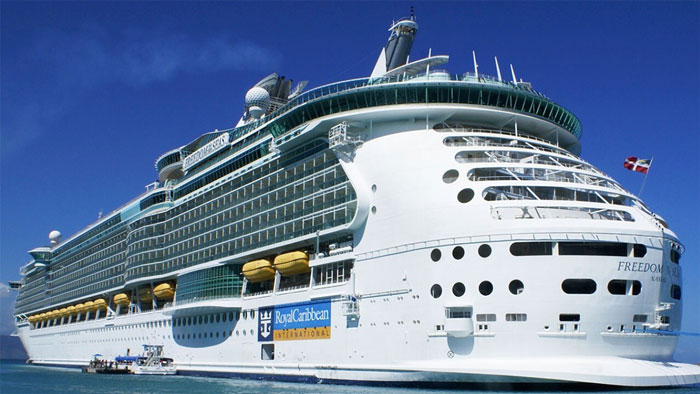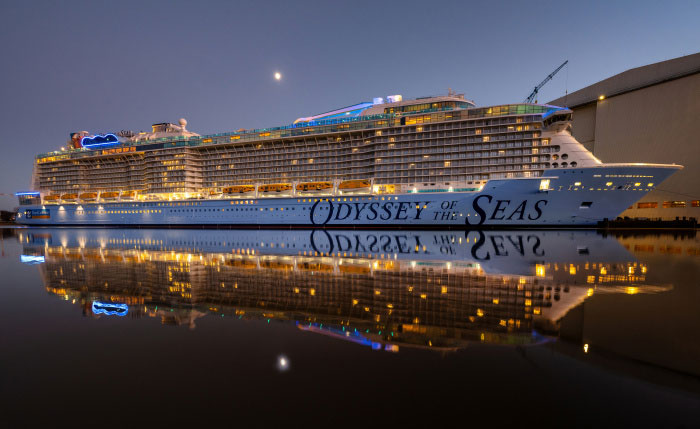How Royal Caribbean (RCL) Makes Money
Feb 26, 2024 By Susan Kelly
Cruise line Royal Caribbean International (RCI) was established in 1968. Silversea Cruises is one of the three cruise brands Royal Caribbean International owns.
According to the company, Royal Caribbean operated 60 ships that visited 1,000 ports throughout the world as of December 31, 2020. Azamara, the business's fourth cruise line, was sold in March of this year, and the corporation now only operates three cruise lines.
Its main competitors are Carnival Corp. (CCL) and Norwegian Cruise Line Holdings Ltd. in the cruise business (NCLH). The company also competes with other travel and tourist organizations that aren't directly in the cruise sector. Customers have a limited amount of time and money to spend on their holiday.
Royal Caribbean Cruises' Financials

A pandemic of the COVID-19 affliction severely disrupted the global cruise industry, with many companies closing down for months. In March 2020, Royal Caribbean halted its cruise operations, which it has since resumed in stages, albeit slowly.
Thirty-six of the company's 60 ships are expected to start sailing or announce plans to begin sailing by 2021.
Royal Caribbean has suffered enormous losses during the pandemic due to the significant disruption to its company. Net losses for the second quarter of 2021, which ended June 30, were lower at 1.3 billion dollars than the losses of 1.6 billion dollars for the second quarter of 2020.
Revenues for Q2 2021 totaled $50.9 million, a significant decrease from the $175.6 million in Q2 2020. As a result of the $50.9 million in ticket sales and onboard revenue, the total revenue was $22.8 million. Passenger ticket revenue declined more severely than the other numbers, decreasing year-over-year.
Royal Caribbean Cruises' Business Segments

For example, Royal Caribbean's numerous cruise brands have identical itineraries, cost and revenue components, consumer types, regulatory environments, and other considerations. That's why they're all lumped together in one place.
However, Royal Caribbean breaks down overall income by itinerary across four regions: North America, Asia/Pacific, Europe, and Other Regions (the latter includes South America and Latin America). Additional revenues reported by the corporation include, among other things, cancellation charges, travel protection insurance premiums, tours, and charges for the use of certain port amenities. The corporation did not disclose a breakdown of profitability for each sector.
North America
Cruises in the United States, Canada, Mexico, and the Caribbean are included in Royal Caribbean's North American itineraries. During the second quarter of 2021, Royal Caribbean's North American cruise itineraries generated $11.6 million in revenue or 22.8 percent of overall revenues. Compared to North American revenues for Q2 2020, this is down 54.5 percent YOY. North America was the second-largest revenue-producing area in the second quarter of 2021.
Asia/Pacific
A tour of Asia/Pacific consists of trips to Southeast Asia, East Asian countries, South Asian countries, and Oceania. These itineraries include cruises in Singapore, the Philippines, Thailand, China, India, Japan, Australia, and neighboring countries. ' In the second quarter of 2021, Asia/Pacific itineraries brought in the most money of any geographical region. A total of $19.3 million in revenue was generated in the Asia/Pacific region during the third quarter, representing 37.9% of total sales. According to Royal Caribbean, this region saw the smallest year-over-year revenue loss among all of the company's geographic regions.
Europe
Royal Caribbean offers European cruises in the Nordics, Germany, France, Italy, Spain, and the United Kingdom in the Europe category. The second-smallest geographic region generated $3.8 million or 7.4 percent of total revenues in Q2 2021. No income was reported for Europe in Q2 2020 by Royal Caribbean. This shows the disastrous effect of pandemic tourism in Europe.
Outside Of The United States
The Other Regions category on Royal Caribbean offers cruises departing from South and Central American ports. Only 3.7 percent of overall revenues came from this segment in Q2 2021, with revenues of $1.9 million. YOY fell by 97.4 percent, which was the greatest drop.
Additional Income
Additionally, Royal Caribbean includes a range of additional revenue streams under the "Other Revenues" section of their financial statements. Royal Caribbean charges its affiliates for various services, such as passenger cancellation fees, holiday protection insurance, shore excursions before and after the voyage, and port facility fees. Revenues from other sources were $14.3 million in Q2 2020 or 28.1 percent of the total revenues. The YOY decline in this category was 62.8%, which was the second-highest decline rate.
Royal Caribbean's Recent Developments
It has been long since Royal Caribbean resumed its cruises in March 2020, but the company has made progress. On August 4, 2021, the firm announced that it has 29 ships in service or 42 percent of its capacity. By the end of the month, it expects to run 36 ships, or more than 60% of its capacity, and 80% of its capacity by the end of 2021.
As a result of the previously unmet demand for cruise vacations, Royal Caribbean reported "extremely favourable" customer reactions to announcements of the company's intention to begin sailing. The company reported a significant increase in customer bookings.
Aside from the new ships and services, the corporation has also taken the opportunity to entice clients who the flu outbreak may otherwise put off. In a press release on September 15, Royal Caribbean revealed that the world's largest ship, Wonder of the Seas, will launch in March 2022, offering cruises in the United States and Europe.
A new ship and celebrity relationships for the Celebrity Cruises brand were announced in September 2021. Daniel Boulud, Nate Berkus, and more will be included in Celebrity Beyond's restaurants and interior design concepts. The maiden trip of Celebrity Beyond is scheduled for April 2022.

How Your Credit Cards Can Help During a Recession
By Susan Kelly / Oct 18, 2023
Learn more about using credit cards responsibly and securely during an economic recession with this helpful blog post. Discover the ins and outs of personal finance in recessions to ensure your money works for you. Start planning today with a little research.

Understanding Mutual Funds
By Susan Kelly / May 18, 2024
Uncover what mutual funds are and how they're priced, as well as the different kinds of mutual funds.

Uncovering The Best-leveraged ETFs in 2024
By Triston Martin / Jan 17, 2024
If you are looking for the best-leveraged EFTs, then this article will help you with this task. The risk factors of leveraged EFTs are also mentioned

Bank Runs Unveiled: A Comprehensive Guide to Definition, Examples, and Operations
By Triston Martin / Dec 04, 2023
Discover the ins and outs of a bank run - definition, examples, and workings. Stay informed on financial dynamics to protect your assets effectively.

Participating In Extracurricular Activities After Retirement
By Susan Kelly / Nov 04, 2023
You don't simply stop doing anything when you retire. There are fewer things to do that will challenge your brain and body. The good news is that plenty of pleasurable and worthwhile pursuits remain to be had even after retirement. You may no longer have time to converse with coworkers as you stroll from the train station to the workplace or break room

Understanding Medical Cost Ratio (MCR) in Healthcare: A Simplified Guide
By Triston Martin / May 16, 2024
Dive into the world of Medical Cost Ratio (MCR). Learn what it is and how it works, and explore examples to grasp its significance in managing healthcare expenses.

All You Need to Know About Gross Margin: Definition, Example, Formula, and How to Calculate it
By Triston Martin / May 19, 2024
This article provides a detailed overview of gross margin, its example, formula, and how you can calculate it.

Finding Out: Who Are Starbucks’ Main Competitors?
By Susan Kelly / Jan 15, 2024
The Seattle-based Starbucks Corporation opened its first store in 1971 and has since expanded to become the world's largest network of coffeehouses. Over 33,000 outlets (both owned and licenced) are already in operation for the brand, and they plan to increase that number to 55,000 by the year 2030. The United States is Starbucks' largest market, with 15,000 outlets, followed by China, where the business expects to open 6,000 locations.

High-Value Home Insurance
By Susan Kelly / Feb 04, 2024
The term "high-value home insurance" refers to a particular kind of homeowner's insurance made accessible for residences with a value of $750,000 or more.

How And Where to Invest in the Dow Jones Industrial Average
By Triston Martin / Oct 17, 2023
The DJIA is one of the most widely followed stock market indices and is calculated as the weighted average price of 30 major, well-known companies. The Dow Jones Industrial Average (DJIA) is not a security that can be bought and sold on its own; instead, investors must purchase other investment vehicles that follow the DJIA or its components to have exposure to its performance. Investing in the Dow Jones Industrial Average (DJIA) may be done in several ways, including purchasing shares of the 30 firms that make up the index, purchasing index funds or ETFs that follow the index, or purchasing the "Dogs of the Dow," the Ten highest-yielding equities on the DJIA.

The Comprehensive Guide to the Foreign Credit Insurance Association
By Triston Martin / May 19, 2024
Explore the FCIA's role in global trade through our comprehensive guide, covering services, application processes, and exporter support.

Explore All About Fairway Independent Mortgage
By Triston Martin / Feb 07, 2024
Want to take mortgage loans and wonder whether you should take them? Read more to know the Fairway Independent Mortgage review.